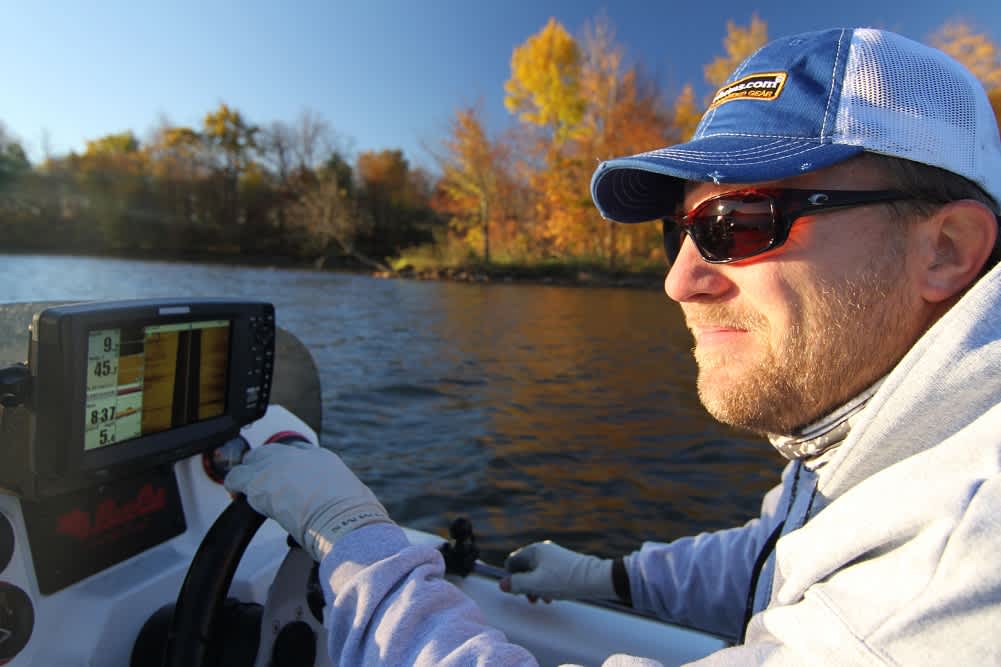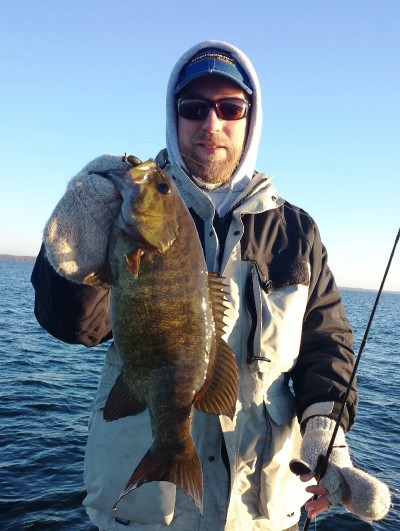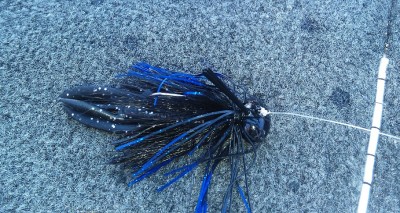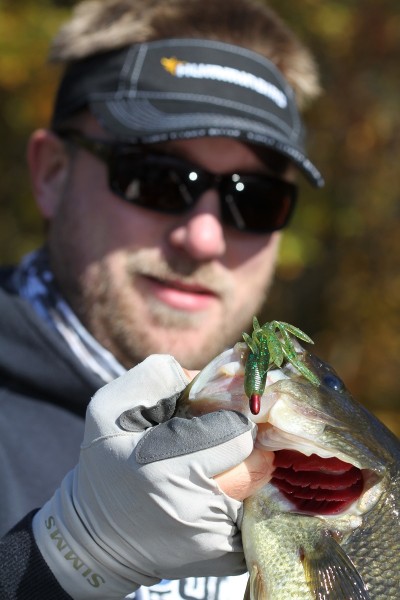Six Strategies for Cold-water Bass Fishing
OutdoorHub Contributors 11.19.13

When the water temperatures plummet in fall, tournament bass angler Rich Lindgren employs numerous cold-water tactics, relying largely on one “jack of all trades bait” called the Kompak Craw for finicky bass in waters below 50 degrees.
“You can fish the bait a lot of different ways, depending on the situation,” says Lindgren. “I typically have rods rigged with the bait on a shaky head, football head jig, finesse rig, [and] Neko rig just for starters. I like having one bait that I can fish so many different ways. Lets me concentrate on fishing, not lure selection.”

Shaky head rigging
Lately, he’s been fishing Evolve Bait Co.’s Kompak Craw on a thin wire 3/0 or 4/0 EWG shaky head and says it recently out-fished the stalwart tactic of dragging tubes over rocks for fall smallmouth an impressive 13 to one.
“Dragging tubes definitely catches fish—from the Great Lakes to southern smallie waters—but there’s something about the Kompak Craw on a shaky head that lights up smallmouth bass. Rather than a horizontal drag, a shaky head orients the bait at 45 degrees—mimicking a fighting craw or goby feeding on the bottom. A simple drag, shake, and dead stick is typically how I fish it. More sitting, though, than shaking.”
The bait’s design lends itself to shaky head rigging, as there’s a bump in the plastic that holds the hook barb just barely under the plastic, eliminating the need to expose the hook. “Even during tough, short bites, hook-up percentages are super good.”
Lindgren says the shaky head routine is a go-to for cold, clear waters less than 15 feet deep. Anything deeper and he’ll fish the Kompak Craw by itself on football jig head or as a trailer on a tungsten football head jig.
Footballin’
There’s nothing like knocking helmets with bass in deep water. Football head jig aficionados will tell you they live for the “thump.” And while it’s effective on deep-structure bass all season long, the football head bite definitely comes alive in fall and early winter, typically around sunken islands, isolated rock piles, and points and ledges in waters from 15 to 40 feet.
To find these high-probability areas, Lindgren says he studies digital GPS mapping and uses Humminbird Side Imaging to look for fish on these deep-water spots, marking waypoints for precise casts.

“During summer months I’ll fish a football head jig with large, flappy craw trailers, but as the water temps go down, you really need something subtle. Fish are moving slower and they won’t eat if it takes too much energy. The Kompak Craw is precisely the thing, whether I skewer it onto a bare football head, a football head jig with silicone skirt, or my favorite, a combination silicone and hair football head jig. Hair moves in a way that mimics life even at a standstill,” Lindgren says.
Finesse jig trailer
On natural lakes—especially those of the Midwest—Lindgren searches for remaining green weed clumps in eight to 10 feet of water, relying on a finesse jig to slowly and methodically find willing largemouth bass.
“I’ll idle just off of weed flats, using Side Imaging to find isolated clumps, funnels, and spaces in the larger beds. Again, I’ll mark waypoints and go back and strategically work those areas with a tungsten finesse jig with Evolve Kompak Craw trailer, which pulls through the weeds without collecting debris. I have a rod rigged with blue and black jig and Leech Fleck or June Bug Kompak Craw, and a rod with green pumpkin jig and Pumpkin Oil or Cali-Melon Red Kompak Craw.”
He’s also a big fan of fishing finesse jigs on reservoirs. “In fall and early winter, I look for areas of chunk rock and gravel around secondary points that transition into coves and creek arms. You can intercept a lot of fish in these locations with finesse jigs as bass move in and out.”
Ika rig

A lesser-known, yet very effective, late-season tactic is called Neko rigging. Basically a highly-refined finesse tactic that takes wacky-rigging to an extreme, it excels in shallow waters and around docks. Although typically used with stick worms, Lindgren says the Kompak Craw is perfect for the Japanese finesse technique. “I invert the bait, insert either a nail or small tungsten screw weight into bait’s head and run a weedless wacky style hook through the side of the bait. When retrieved, the vertically-oriented bait puffs the bottom much like a cat—‘Neko’ in Japanese—in a litter box, hence the name.”
Lindgren says the Neko rig is ideal for dock skipping and bottom-hopping shallow flats, shoreline cover, and points, even when water temps are extremely low. “Especially in stained waters, you’d be surprised how many fish you’ll find shallow in late fall and winter.”
Punch bait
During cold bluebird skies and cold fronts, bass will cling tight to cover—especially weed mats and clumps—for warmth. That’s when Lindgren turns to the Kompak Craw for punching right into the bedrooms of big, lethargic bass.
“Florida waters are a good example of where cold water punching can definitely pay off. And rather than using a bait that’s too obtrusive and can spook fish, the Kompak Craw is streamlined and punches great. It’s thick enough that it displaces water and fish know it’s there but it doesn’t flail; the appendages stay close to the body, moving just the right amount to draw strikes.”
Lindgren fishes the bait on a straight shank 4/0 flipping worm hook with weight stop and 3/4- to 1-1/2-ounce tungsten bullet weight, tied to 25-pound fluorocarbon for clearer waters or 50- to 65-pound braid in dirtier waters.
Drop shot
Yet another way Lindgren likes to fish the bait is on a drop shot, particularly over deep brush piles that he spies with his electronics. “I simply nose hook the Kompak Craw and let it flutter as I ply deep brush, barely shaking it, keeping my eyes on my Humminbird 2D, which I set to 200/83kHz for the widest transducer cone, with my chart speed jacked up all the way to ten. That refreshes data the fastest. It’s like sight fishing with electronics.”

